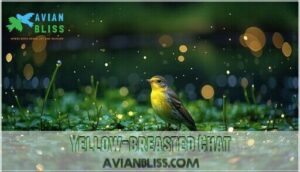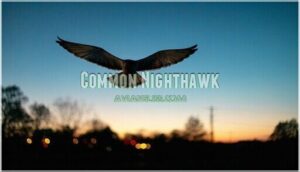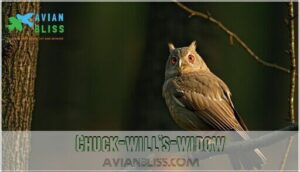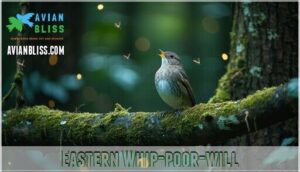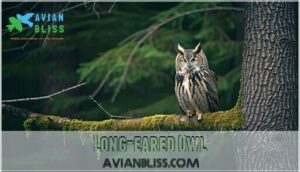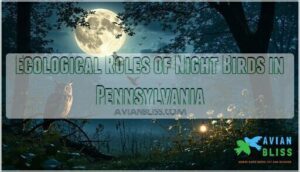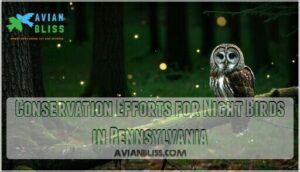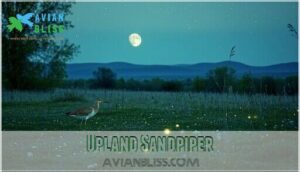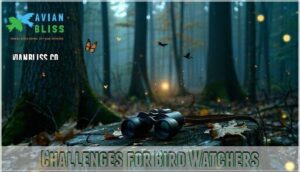This site is supported by our readers. We may earn a commission, at no cost to you, if you purchase through links.
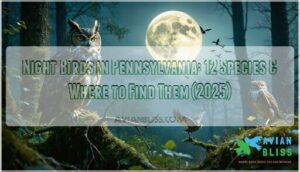
Common species include Northern Mockingbirds (those 2 AM serenaders), Eastern Whip-poor-wills, Barn Owls, and Barred Owls with their distinctive "who-cooks-for-you" calls.
Black-crowned Night-Herons hunt near waterways, while Common Nighthawks perform dramatic aerial displays during summer evenings, and these nocturnal hunters control pest populations and indicate healthy ecosystems across Pennsylvania’s diverse habitats.
Understanding their unique calls, preferred habitats, and seasonal patterns transforms mysterious midnight sounds into exciting wildlife identification opportunities, especially during peak vocal activity when breeding seasons bring the most spectacular nighttime concerts.
Table Of Contents
Key Takeaways
- You’ll identify 12+ night bird species in Pennsylvania by learning their distinctive calls – from Great Horned Owls’ deep hoots to Eastern Whip-poor-wills‘ repetitive chants and Barred Owls’ "who-cooks-for-you" questions.
- You’ll find these nocturnal birds in diverse habitats including suburban neighborhoods, southern woodlands, wetlands, and farmlands, with each species preferring specific environments for hunting and nesting.
- You’ll contribute to vital pest control services as these night birds naturally manage rodent populations, control agricultural pests, and maintain healthy ecosystem balance across Pennsylvania’s landscapes.
- You’ll have the best success during breeding seasons when spring and summer bring peak vocal activity, making identification easier through tools like eBird tracking while supporting conservation efforts.
Types of Night Birds in Pennsylvania
You’ll discover 13 distinct nocturnal bird species calling Pennsylvania home, from the haunting hoots of Great Horned Owls to the unmistakable "whip-poor-will" chant echoing through summer forests.
These night-active birds range from tiny Eastern Screech-Owls hiding in backyard trees to impressive Barred Owls patrolling wetland edges with their curious "Who cooks for you?" calls.
Northern Mockingbird
You’ll recognize the Northern Mockingbird’s impressive vocal mimicry during nighttime serenades when this talented songster performs its nocturnal habits.
These talented mimics cycle through dozens of borrowed songs in moonlit performances.
These Pennsylvania bird species showcase remarkable bird behavior, cycling through dozens of borrowed melodies in their mockingbird songs. Night singing helps males attract mates while avoiding daytime competition from other nocturnal birds.
- Gray-brown birds with white wing patches flashing during flight
- Long tails that cock upward like exclamation points
- Piercing yellow eyes that seem to judge your birding skills
- Fearless defenders diving at cats, dogs, and unsuspecting joggers
- Urban adapters thriving in suburban backyards and city parks
Yellow-breasted Chat
You’ll discover Yellow-breasted Chat’s distinctive night bird calls echoing through Pennsylvania’s summer forests as these vibrant songbirds seek mates.
These nocturnal birds transform quiet woodlands into concert halls with their varied song patterns during breeding season.
- Breeding Habits: Males sing persistently at night to attract females in dense thickets
- Nesting Sites: They prefer shrublands and forest edges for secretive ground-level nests
- Migration Routes: Summer residents arrive from Central America for Pennsylvania’s breeding season.
Their feeding behavior includes hunting insects while maintaining their secretive nature in thick vegetation.
Common Nighthawk
You’ll spot the Common Nighthawk’s distinctive white wing patches during its evening aerial displays above Pennsylvania’s open areas.
These skilled insect hunters perform dramatic dives, creating loud "peent calls" that echo through summer nights.
Their nocturnal habits make them challenging to observe, but you can’t miss their booming courtship flights from April through October during nighthawk migration.
| Feature | Details |
|---|---|
| Wing Patterns | Bright white patches near wing tips, visible during flight |
| Habitat | Open fields, rooftops, gravel areas for nesting |
| Call | Sharp "peent" sound, diving display creates booming noise |
Watch for these Pennsylvania bird species at dusk when they emerge to hunt flying insects.
Their camouflaged plumage helps them blend with gravel surfaces during daylight hours.
Chuck-will’s-widow
Chuck-will’s-widow night-songs echo through Pennsylvania’s southeastern woodlands like nature’s mysterious metronome.
You’ll hear their distinctive five-syllable chucking call during warm summer evenings when these secretive nightjars emerge from dense forest cover.
Five ways Chuck-will’s-widow calls captivate night bird enthusiasts:
- Rhythmic precision – Their chucking pattern creates an almost hypnotic woodland soundtrack
- Volume control – They can project calls over half a mile through thick forest canopy
- Seasonal timing – Peak calling occurs during May breeding season in pennsylvania nocturnal birds communities
- Location mystery – You’ll hear them but rarely see these master camouflage artists
- Dawn chorus – They often call until sunrise, unlike other night birds in Pennsylvania
These long-distance migrants prefer mature deciduous forests with open understory for their nocturnal behavior and ground-nesting sites.
Understanding the role of pennsylvania birds is essential for conservation efforts and appreciating the ecosystem’s balance.
Eastern Whip-poor-will
You’ll hear the Eastern Whip-poor-will’s signature three-syllable call echoing through Pennsylvania’s deciduous forests during summer nights.
These secretive nocturnal birds repeat their namesake song up to 400 times per hour, making identification easy despite their cryptic brown plumage that blends perfectly with leaf litter.
| Characteristic | Details | Season |
|---|---|---|
| Call Pattern | 3-syllable "whip-poor-will" | Spring-Summer |
| Activity Peak | Moonlit nights, dawn/dusk | May-August |
| Habitat | Deciduous/mixed forests | Breeding season |
| Migration | Central/South America | Fall departure |
| Feeding | Flying insects, moths | Nighttime only |
Black-crowned Night-Heron
Among Pennsylvania’s wetland shadows, the Black-crowned Night-Heron emerges as darkness falls, transforming from motionless statue to stealthy predator.
When twilight cloaks Pennsylvania’s waters, silent hunters awaken to their ancient calling.
This stocky wader’s distinctive silhouette haunts marshes and streams where night birds in Pennsylvania thrive.
Here are 5 key facts about Pennsylvania’s Black-crowned Night-Heron:
- Nocturnal Behavior: Hunts fish, frogs, and crustaceans exclusively after sunset
- Heron Habitat: Prefers shallow wetlands, ponds, and slow-moving streams
- Night Herons Identification: Red eyes, black cap, and signature hunchbacked posture
- Bird Migration: Arrives in spring, departing before winter freeze
- Heron Conservation: Benefits from protected wetland restoration projects
You’ll recognize their harsh "kwok" call echoing across water. These nocturnal birds remain Pennsylvania wildlife’s most secretive herons, requiring patience to observe.
Great Horned Owl
Pennsylvania’s apex predator commands respect through sheer presence.
The Great Horned Owl‘s distinctive ear tufts and piercing yellow eyes make identification easy among night birds in Pennsylvania.
These Pennsylvania owls excel at hunting tactics, using exceptional night vision and feather camouflage to ambush prey silently.
Unlike the Barred Owl’s territorial calls, they communicate through deep hoots during nesting behavior season.
Find them in diverse owl habitat from forests to urban parks, where mature trees provide perfect roosting spots.
Barn Owl
Unlike the Great Horned Owl‘s booming calls, you’ll hear the Barn Owl’s harsh, raspy screech echoing through Pennsylvania’s farmlands at night.
This ghostly white nocturnal hunter glides silently on pale wings, using exceptional hearing to locate prey in complete darkness.
Its heart-shaped face acts like a satellite dish, funneling sounds toward asymmetrically placed ears that pinpoint voles and mice with surgical precision.
The Barn Owl’s feather camouflage and silent flight make it nearly invisible during nocturnal hunting expeditions.
Though uncommon in Pennsylvania, you’ll spot these night birds in southern regions where open country meets old barns and silos—perfect owl nesting sites for this remarkable pa bird species.
Barred Owl
The Barred Owl’s distinctive "Who cooks for you?" call echoes through Pennsylvania’s mature forests, making it one of the most recognizable nocturnal birds.
These medium-sized owls sport brown and white feather patterns with horizontal chest bars that give them their name.
You’ll find their owl habitat near wetlands where they hunt small mammals, amphibians, and crayfish using patient hunting tactics. Their nesting sites include tree cavities in dense woodlands.
Unlike strictly nocturnal species, Barred Owls are active during dawn and dusk, making them easier to spot than other night birds in Pennsylvania, and they are known for their "Who cooks for you?" call and horizontal chest bars.
Long-eared Owl
You’ll spot this secretive hunter by its distinctive ear tufts that stand tall like feathery exclamation marks.
Long-eared owls rely on exceptional night vision and feather camouflage to blend seamlessly into dense woodlands.
Their hunting tactics involve silent flight and precise strikes on small mammals.
Despite habitat loss threatening night birds in Pennsylvania, these nocturnal birds maintain populations through adaptive owl behavior.
Unlike the barred owl’s bold hooting, long-eared owls communicate with soft, low hoots that echo through Pennsylvania’s forests.
Ecological Roles of Night Birds in Pennsylvania
Night birds in Pennsylvania play vital ecological roles that you’ll appreciate once you understand their impact on local ecosystems.
These nocturnal species contribute to habitat diversity, provide essential pest control services, and even assist with pollination in ways that might surprise you.
Habitat Diversity
Night birds across Pennsylvania showcase remarkable adaptability, thriving in diverse environments from Forest Ecosystems to Urban Landscapes.
These nocturnal bird species have mastered the art of habitat selection, with each species finding its perfect niche. Pennsylvania night birds demonstrate incredible versatility in their habitat preferences. Understanding the owl species basics is essential for appreciating their role in the ecosystem.
Consider how these nocturnal birds utilize different environments:
- Wetland Areas – Black-crowned Night-Herons patrol marsh edges while Common Nighthawks hunt insects over open water
- Mountainous Regions – Great Horned Owls claim rocky outcrops and mature forest canopy for nesting territories
- Rural Environments – Barn Owls convert agricultural buildings into hunting headquarters, controlling rodent populations
This habitat diversity strengthens Pennsylvania wildlife communities, ensuring nocturnal birds maintain stable populations across varied landscapes throughout the state.
Pest Control
Pennsylvania’s nocturnal birds serve as nature’s pest control specialists, delivering impressive insect management and rodent control services.
Great Horned Owls hunt rabbits and rodents with surgical precision, while Barred Owls target small mammals near wetlands.
Common Nighthawks excel at aerial insect capture, reducing agricultural pest populations, and these nocturnal bird species maintain wildlife balance by controlling disease-carrying rodents and crop-damaging insects.
Their hunting effectiveness surpasses many artificial bird deterrents, making them valuable allies in pest ecology management throughout Pennsylvania’s diverse ecosystems.
Effective land use strategies are essential for preserving these bird populations and their pest control services.
Pollination
While most people think of bees when discussing pollination, night birds in Pennsylvania quietly contribute to this essential ecosystem service.
Though their role is smaller than diurnal pollinators, these nocturnal species support plant diversity through specialized floral adaptation relationships.
Here’s how night birds help combat pollinator decline:
- Ruby-throated hummingbirds visit evening primrose and moonflowers during twilight hours
- Nectar-feeding owls occasionally transfer pollen between night-blooming plants
- Insectivorous species control pests that damage pollinator-dependent crops
- Seed dispersers like mockingbirds spread plants that support bee conservation
- Habitat creators maintain diverse ecosystems supporting multiple pollinator species
This nighttime wildlife activity demonstrates how bird species diversity strengthens Pennsylvania’s ecological web, supporting both traditional pollinators and owl conservation efforts.
Conservation Efforts for Night Birds in Pennsylvania
You’ll find Pennsylvania’s night birds face serious threats from habitat loss, light pollution, and climate change that require active conservation efforts.
The state has implemented specific protection programs for vulnerable species like the Common Loon, Eastern Screech-Owl, and Upland Sandpiper to guarantee these nocturnal hunters continue thriving in Pennsylvania’s diverse ecosystems.
The conservation of these species is crucial to maintain the balance of Pennsylvania’s diverse ecosystems.
Common Loon
Gliding across quiet lakes at dusk, the Common Loon is a showstopper among night birds in Pennsylvania.
You’ll recognize its striking feather camouflage—bold black-and-white checks—paired with haunting Loon Calls that echo over water.
Loon Migration brings these divers to northern lakes each spring, where their aquatic habitat is key for nesting and feeding.
Their diving behavior is Olympic-level, disappearing underwater in a blink.
Sadly, threats like mercury and shoreline development challenge their survival.
If you’re bird watching PA, cherish these Pennsylvania nocturnal birds—future generations are counting on you, to help preserve their aquatic habitat.
Eastern Screech-Owl
You’ll spot Eastern Screech-Owls adapting remarkably well to human development, unlike their more sensitive cousins.
These compact raptors with distinctive feather camouflage maintain stable populations through exceptional owl behavior flexibility.
Their screech calls echo from suburban owl habitat where cavity-bearing trees provide nesting sites.
Night hunting prowess keeps these resilient night birds in Pennsylvania thriving despite urbanization pressures, showcasing their exceptional owl behavior.
Upland Sandpiper
Most Upland Sandpipers in Pennsylvania face severe habitat loss, threatening their survival.
These night birds in Pennsylvania navigate complex migration patterns between South American wintering grounds and Midwest breeding areas. Their secretive nesting habits and nocturnal bird behavior make conservation challenging.
Key conservation efforts include:
- Prescribed burns – Restoring native grassland ecosystems
- Delayed mowing schedules – Protecting breeding sites during nesting season
- Population monitoring programs – Tracking bird migration patterns and conservation status
You’ll rarely hear night bird sounds from these elusive sandpipers, but Pennsylvania birding enthusiasts support habitat restoration efforts that benefit multiple grassland species. Effective bird conservation efforts are essential for protecting these species and their habitats.
Challenges for Bird Watchers
You’ll face unique obstacles when trying to spot Pennsylvania’s night birds, from distinguishing similar calls in darkness to adapting your techniques across seasons.
The good news is that modern tracking tools like eBird can help you overcome these hurdles and build your nocturnal birding skills.
Identifying Night Birds
Anyone can master identifying night birds in Pennsylvania with the right techniques.
Start by learning nocturnal calls—each species has distinct vocalizations that cut through darkness.
Great Horned Owls deliver deep hoots, while Eastern Screech-Owls trill softly.
Study bird plumage and feather patterns during daylight encounters to recognize silhouettes later.
Wing shapes help too—nighthawks show distinctive white patches.
Your night vision improves with practice, making owl identification easier.
Use bird watching techniques like cupping your ears to amplify night bird calls.
Remember, patience beats rushing when spotting these elusive creatures.
Investing in good bird watching binoculars enhances the overall birding experience.
Seasonal Variations
Night birds in Pennsylvania follow distinct seasonal variations that’ll keep you on your toes throughout the year.
Understanding these migration patterns and breeding seasons helps you know when and where to listen for nocturnal bird calls.
Seasonal timing affects your Pennsylvania birding success:
- Spring – Nesting cycles begin as migrants like common nighthawks return
- Summer – Peak breeding seasons bring chuck-will’s-widows and whip-poor-wills
- Fall – Bird migration creates opportunities to spot transient species
- Winter – Wintering habits of resident owls become more predictable
Feather molting also influences detection rates seasonally.
Using local bird guide resources can enhance your understanding of these patterns.
Limited Studies
Research gaps plague night birds in Pennsylvania studies, creating knowledge voids about these elusive species.
Scientists struggle with data analysis because nocturnal bird calls and behaviors remain largely undocumented.
Traditional study methods fall short when tracking species that vanish at sunrise.
You’re witnessing this research challenge firsthand when you hear mysterious hoots echoing through Pennsylvania forests.
Limited studies mean we lack thorough statistical models for population trends and habitat preferences.
Field observations become nearly impossible without specialized night-vision equipment and audio recording technology.
These research gaps affect conservation efforts for night bird behavior monitoring.
Your nocturnal bird call recordings could help scientists develop better study methods and fill critical data holes in Pennsylvania’s avian research landscape.
Effective birdwatching techniques, including bird identification skills, are essential for contributing to citizen science projects and advancing our understanding of night birds.
EBird Tracking System
The Pennsylvania Audubon Society’s eBird platform revolutionizes nocturnal bird watching through advanced tracking software.
This citizen science powerhouse enables you to:
- Log bird data with GPS coordinates and timestamps
- Map species distribution across Pennsylvania’s diverse habitats
- Monitor habitat changes affecting night birds in Pennsylvania
eBird’s real-time database processes your nocturnal observations, creating valuable resources for researchers studying Pennsylvania birding patterns and nocturnal birds behavior.
The eBird Tracker system relies on accurate bird tracking devices to guarantee reliable data collection.
Frequently Asked Questions (FAQs)
What time do night birds start singing?
Like clockwork striking midnight, you’ll hear Pennsylvania’s night birds beginning their serenade around dusk—typically 30 minutes before sunset.
Most species become vocal as darkness falls, though some owls start calling earlier during breeding season.
How to attract nocturnal birds to backyard?
Create sheltered areas with dense shrubs and install nest boxes at varying heights to provide roosting spots.
Reduce outdoor lighting, add water features, and maintain quiet spaces during evening hours when they’re most active, utilizing these elements to support the creation of a peaceful environment with dense shrubs.
Are night birds dangerous to humans?
You’ve probably heard that night birds are dangerous predators lurking in the darkness—but that’s mostly myth.
Pennsylvania’s nocturnal birds like owls, nighthawks, and whip-poor-wills pose virtually no threat to humans, focusing instead on small prey like rodents and insects.
Do night birds migrate in winter?
Most night birds you’ll encounter don’t migrate – they’re year-round residents. However, Common Nighthawks and Eastern Whip-poor-wills pack up for warmer southern territories when winter arrives.
What sounds scare away night birds?
Ironically, the birds you’re trying to keep quiet respond best to loud, sudden noises.
You’ll find success with clapping, banging pots, or using air horns to startle them away from your property.
Conclusion
Like a symphony orchestra tuning up before the main performance, night birds in Pennsylvania create their most enchanting concerts during spring and summer breeding seasons.
You’ll discover these twelve species by learning their unique calls, understanding their preferred habitats, and timing your outings for peak activity periods.
Whether you’re tracking the Great Horned Owl’s territorial hoots or listening for the Chuck-will’s-widow’s repetitive serenades, each encounter deepens your connection with Pennsylvania’s nocturnal wildlife community and contributes valuable data to conservation efforts.
- https://globalbirdinginitiative.org/bird-identification/species-by-location/pennsylvania-us/night-birds-in-pennsylvania/
- https://www.hummingbirdsplus.org/nature-blog-network/types-of-birds-in-pennsylvania-the-most-common-backyard-birds/
- https://www.pa.gov/agencies/pgc/wildlife/wildlife-viewing/birding.html
- https://animals.mom.com/nocturnal-birds-in-pennsylvania-12562525.html
- https://www.birdzilla.com/learn/birds-of-pennsylvania/


